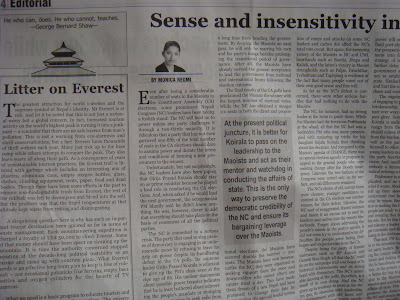It was on a quirk that I decided to join guys on trek to Everest base camp just when my 2 weeks vacation was coming to an end. Soon I was on flight to Kathmandu where I met Barada and two other guys Arvind and Rohan.
Day -3 (April 22nd ): I Reached Kathmandu in evening and met Barada, Arvind and Rohan; all of whom came on different flights from Delhi. I had arrived 1 hour earlier; I was loitering about in airport compound being continuously pursued by omnipresent hotel/taxi /trek guides and agents. One of the guys struck some interesting conversations, quite predictably about Bollywood, khans, cricket am Prashant Tamang. Once other guys arrived, we went to domestic airport to book flight to Lukla. Lukla is a the starting point for treks in Everest region and can only be reached by small propeller planes. I heard of this place for first time but for next couple of days Lukla was to acquire a hallowed status of a mystical place in our mind. There are around 3 local airlines operating flights to Lukla, but all of them fly before afternoon so we booked the early morning flight on Yeti Airlines for next day.

(In Thamel, Kathmanudu's main tourist place)
At night we checked into a hotel in main tourist destination in Kathmandu called Thamel. Like any other tourist hub, Thamel has many budgets hotels, lodges, restaurants and dance bars. After some nice dinner in forms of Thupkas, Barada and chief organizer of Trek Aravind started planning the trek. The problem was that Everest base camps needed minimum of around 13 days with couple of days of height acclimatization thrown in , but we had just 9 days. We decided to push harder on certain sections of route and if required spend just one day for acclimatization. We had a rather lavish dinner at place called oak tree and retired for night.
Day -2 (April 23)We reached airport to catch the flight to Lukla. As it turned out the weather at Lukla was bad and flights were not able to land there. We waited till noon, when flights were finally cancelled for the day. Since we had squeezed trek into 9 days, it was a bad news for us. Reaching Lukla by road was out of question as it took 2 days of trek to Lukla from its nearest road head. We re-scheduled our flight to Lukla for next day. Since we had time to spend, we walked from airport to top of a hillock and down to famous temple of Pashupatinath. Temple looks quite stunning from inside and is worth a visit. Though it could be cleaner and more inclusive as only Hindus are allowed inside the temple. The ghat near the temple reminds one of Varanasi with burning pyres, final destination of all men ...be kings or paupers.
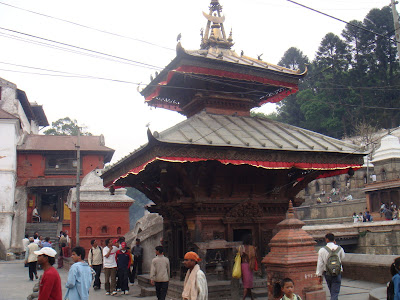
(Pashupatinath from outside)
We spent the night in Thamel again treating ourselves to yet another lavish dinner and drinks with some nice live music. It was second night in Thamel and we were starting to behave like tourist and not trekkers.
Day -1 (April 24): We were back at airport for early morning flight. We were quite apprehensive if flight to Lukla would be possible today and the fears of another day going waste appeared real when flight was delayed by 2 hours. I and Aravind went out of airport to bring some breakfast as food at airport was costly. When we returned after hearty Bread omelet, to our horror, we realized that the flight to Lukla had waited for us and eventually taken off. Barada and Rohan had boarded the flight and we had missed it. That was ominous. We could get our seats adjusted for another flight due in an hour's time. As we were waiting, we came to know that Barada and Rohan had come back as their flight couldn't land at Lukla. It was as near as any of us could get to Lukla. The weather at Lukla had turned bad. To add to our misery we came to know that a flight which took off barely 15 minutes before our flight could land at Lukla. Had we not gone out for breakfast and had the flight not delayed due to us, we could have been on the flight which had landed. Around noon it was declared that flights to Lukla were cancelled for day. Another day wasted. Lukla started to sound like a place where we just couldn't get to. Or was somebody stopping us from reaching there. There was a decision to be made. Either we wait for another day to try reaching Lukla or change our plans or do some other trek. Annapurna trek is what Barada thought we could do in time which we had. But Mystery of Lukla was too overwhelming and we decided to try another day to reach Lukla and do a curtailed trekking in region but not actually doing base camp. We took a taxi to a place called Swambhu, a famous Buddhist shrine on top of hill.
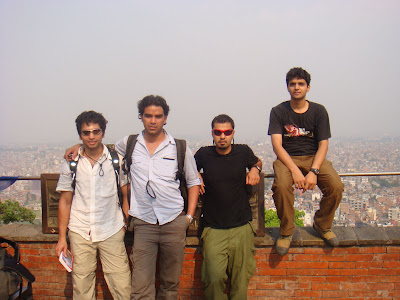
(All of us at Swyambhu Budhist temple)
At night we stayed at heart of Thamel, had beer , got stoned and watched "
Touching the void" on Barada's laptop. A fantastic account of two guy's climb of a Peruvian mountain gone horribly wrong. It is a must watch movie as it shows the strength of a man’s will power in surviving against all odds.
Day 1 (April 25) From Kathmandu to -Pokhra - To Ghandrug
Early morning and with an unsaid trepidation we reached airport again and hoped that flights to Lukla would take off today. As the destiny would have it, the flights started getting delayed, a pattern we had got accustomed to in past 2 days. Since we were desperate to do some trekking now and Everest base camp trek was out of question, we changed our plans to fly to Pokhra and do Annapurna base camp (ABC) trek. Pokhra is second largest city in Nepal and is hub for trekkers in Annapurna region. We could finally land in Pokhra at noon on Yeti's jetstream aircraft which took 25 minutes to reach Pokhra from Kathmandu. Barada's ever planning mind (thanks to guide books) had thrown another idea of doing a wilderness trek and camping in the Himal peak instead of doing a tea-house trek to Annapurna Base camp (ABC) . We rushed to tourism office in Pokhra where Barada and Aravind collected information about logistics and cost of doing a camping trek with porters and cook. In an hour we realized that Camping trek would be costlier and also we possibly wouldn't be able to climb a trekker’s peak as it needed some technical climb in certain stretches. By now the desperation to do hit the trail was running high and we registered with TIMS and took taxi to Nayapul. We reached Nayapul at around 2.30 pm. This was to be start of trek at height of 800 mt.

From Nayapul we walked to Birthanti in 20 minutes and another 50 minutes walk took us to Sayali bazar. This was the beginning of hard trek as from Sayali bazar to Kimche village was a steep hike. It was a back breaking climb made more difficult by the fact that we were climbing stony staircase . Half way up the climb and I found myself panting, sweating and cursing. My fitness level was down to zero due to many months of sedentary lifestyle and my body was complaining against sudden burst of hard climb. We finally reached Kimche at 1530 mts., after 2 hrs of Trek. The trail though steep and uphill, provides one of good view of fertile terraced fields and small villages around them. Kimche provide a good view of Modi river valley around Birthanti from where we had climbed 700 mts. After resting for a while in Kimche we decided to push for another hour and reach Ghandrug for night halt. The trail from Kimche to Ghandrug is again uphill and it takes around 1 hrs to reach Ghandrug from Kimche. The night was falling and I had to wait for Rohan who was walking on steady pace. Walking at night with torches on, with a star lit sky and gentle breeze blowing was a fascinating experience. I and Rohan reached Ghandrug around 8 pm and all of us stayed at very first lodge we could find in Ghandrug (2000 mts). IN about 5 hours , we had gained a height of around 1200 mts. After Dinner we had random and sometime heated talks on religion, nature, population and politics and it was to become more or less norm for rest of trek. We had best of sleep at Ghandrug.
Day 2 (April 26): From Ghandrug – to- Chomrong
We woke up pretty early and we had our first look at the distant Snow clad mountains. In this season it is only during mornings that one can have a clear view of mountains. After noon, they are covered by clouds and mist in valleys makes it impossible to see the mountains. From Ghandrug we started trekking at 7 am. An uphill climb of 1.15 hours took us to Komrong Danda at height of 2240 mts. We had possibly one of worst breakfast here. The musli smelt foul and I almost threw up. From Komrong Danda we had to descend by 500 mts to reach Komrong Khola (river or stream). The descend was easy and we reached Khola in 45 min. We had a refreshing bath in the Stream and then started one of steeper uphill trek to Chomrong. Since we hardly had any breakfast and sun was beating hot ,the climb was painful and dehydrating. I and Aravind ran out of water. We should have been carrying minimum of 2 liters of waters on each person as on this trail there is no water midway. Dehydration makes every single step into an agony.
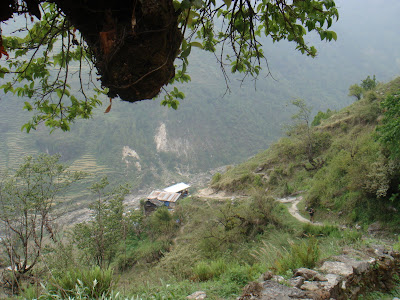
(On way from Ghandrug to Chomrong)
We finally reached Chomrong after 2.15 hours of trek from Khola and drinking lemon water was akin to drinking nectar. Thanks to Komrong Khola our net height gain was almost 0 as Chomrong is at same height as Ghandrug. Chomrong has many lodges and is spread across the hill with some of nicest lodges situated on top of hill. Chomrong is an interesting village as lower Chomrong is around 300 meters below the upper Chomrong and is connected to it through a never ending stone staircase. Barada had read that Chomrong guesthouse prepares delicious pizzas and we started looking for it. The first look of Guesthouse disappointed us as it looked desolated and haunted. Its business seems to have been snatched by more appropriately situated lodges at upper Chomrong, but pizzas which lady of the guesthouse prepared were absolutely fantastic. Best pizzas after Pizza hut and quite unexpected food while on a trek. We stayed for night in excellent view lodge in upper Chomrong. From Chomrong onwards prices of food items were to rise as everything has to be carried by porters and Simple Daal-bhat cost as much as 200 NR.
Day 3 (April 27): From Chomrong -to -Deurali
We woke up early at 5.30 am and were greeted by stunning view of Machhapuchre and Annapurnas.The sight of first rays of rising sun falling over Annapurna and golden hue thus created on them is a stunning visual spectacle. For some it could be a spiritual sight, for others nature at its best and for some others, it can be poetic. If these mountains were to be Gods and trekkers were to be their devotees, then early morning is the time when Gods give their devotees a divine darshan.
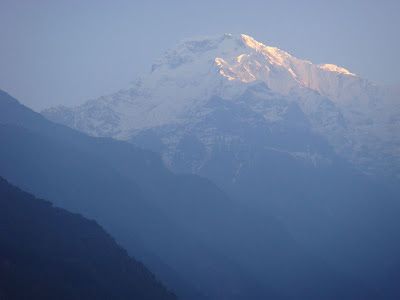
(Sun rise on distant Annapurna seen from Chomrong)
Chomrong is the last village in the region and for rest of trail we wouldn't see any other village after Chomrong. All the lodges on trail beyond Chomrong are owned by villagers (mostly Gurungs) from Chomrong. We started from upper Chomrong at 6.45 am and descended by a stony staircase to Chomrong khola and then did a steep climb up to Sinuwa. Sinuwa is practically at same height as Chomrong. From Sinuwa we passed through a beautiful up-down tree covered trail until the Khuldi ghat. From khuldi ghat we descended further to Bamboo which gets it name from Bamboo forests in vicinity. We reached Bamoo at 10am and it was slightly chilly and a cup of hot ginger milk tea was a welcome relief. From Bamboo we started climb to Dovan and then Himalya. We stopped in Dovan for our lunch By the time we reached Himalya at around 3pm the weather had turned bad and it had started raining. The chill in air was palpable and jackets were out. Even though we had decided to stay at Himalya, Barada wanted to push till Deurali which was at height of 2900 mts and could be better option to spend night and get some acclimatization before climbing up to the base camps. Barada was particularly scared of anyone getting AMS or altitude sickness and wanted to take precautions of not gaining height rapidly. Aravind stayed in Himalaya for night and rest of us pushed to Deurali. The weather by now had gone bad and hails were raining down on us. I particularly enjoyed hike from Himalaya in deteriorating weather and fading light. The vegetations on the trail were becoming sparse and mountains were becoming barren and had snow deposited on them in patches. The whole spectacle around us was mystically beautiful.
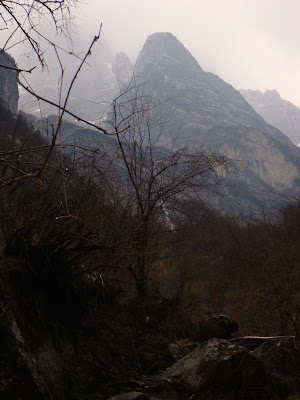
(on way to Deurali)
After the steep hike we reached the Hinku Cave from where we could see Deurali with its 3 lodges. From the Hinku cave to Deurali there is a avalanche and landslide prone area. When we reached Deurali, we got little scare as two of 3 lodges had no rooms. We finally got room in 3rd lodge. It was very cold and snow had started on mountains. We moved to only heated area in the lodge which is like a big dinner room in front of kitchen. A kerosene stove is put under the huge table which is covered by clothes from all four sides. Trekkers sit around the table and can put their hands and feet beneath the cloth to warm themselves. Cost is 70 NR for every person. No wood fires are allowed in Annapurna sanctuary region Two of lodges here have solar powered electricity. In lodge where we stayed there wasn't any electricity. After hot and spicy daal-bhat, we retired to bed in darkness. It was raining outside with thunderstorms, the cold was increasing and seeping into primitive lodge and ambience was prefect to share some ghost stories. We found harder to sleep, possibly due to cold or due to height.
Day 4 (April 28): From Deurali to MBC-ABCArvind joined us from Himalaya and we started trek to Machhapuchre Base Camp (MBC). From Deurali, towards MBC, there are quite a few avalanche prone areas and trail first climbs gently through a river bed until it rises steeply over the mountain side towards MBC. 30 mins walk away from Deurali; we found ourselves in middle of river bed surrounded by giant looking mountains with their upper portions covered by snow and lower portions showing stony barren features. When the sun arose, the snow on mountains shone and river valley was filled with warm sun rays. The spectacle was exhilarating. It was quite indescribable in fact.
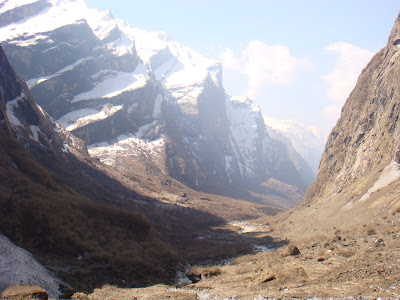
(On trail from Deurali to MBC)
The hike to MBC is tiring but the views keep one going. We reached MBC around lunch time and had our first close up view of majestic Machhapuchre. It looks stunning and when you are that close to a peak, standing right at its base, you realize how hard it must be climbing these giants. They look unreachable. Machhapuchre looks like a huge column of rock and snow with razor thin ridges. How can anybody climb it!! What strength and stamina one must have to climb such peaks. I think one must be mad to climb. Barada wasn’t feeling very well and though he was suffering from some altitude sickness and wanted to rest for day before going to ABC. But after couple of hours rest, we decided to push forward to ABC.

(MBC base camp)
From MBC to ABC trail is pure magic. Vegetation disappears sans some grassy patches on ground. You see snow boulders melting and forming small gurgling water streams. Many such streams from melting snow collectively form rivers downhill.
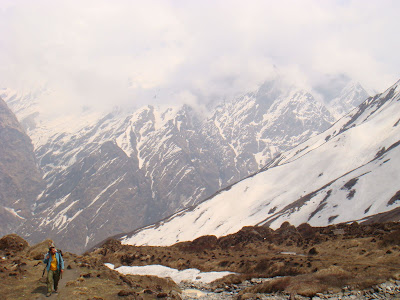
(on way to ABC)
After a hike of just 30 mins or so, we could see the Annapurna Base camp at far side of trail. Finally we were to reach the basecamp. It took us another 30 min of slightly labored walk to reach basecamp and it was an exhilarating feeling. Here we were at 4200 mtrs height surrounded from all sides by huge snow clad Annapurna. From here only trained climbers can scale the peaks. It started snowing soon after we reached the camp and in few minutes the whole area was covered in whiteness.
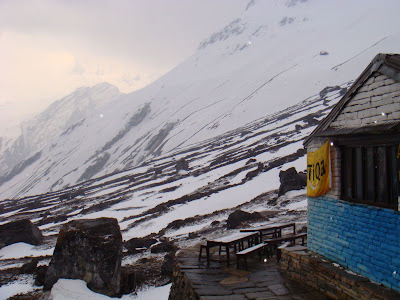
(Annapurna Base Caamp at 4200 mtrs)
We stayed in one of 3 lodges and straightaway made ourselves comfortable in warm dinner room. There were some interesting discussions happening there among a motley group of residents. There was an old Russian who had climbed Everest twice before quitting climbing, a lady trekkers who was hooked to Yoga and natural way of living and an American TV cameraman climber who was in basecamp since a month as part of expedition to climb Annapurna peak. The poster on wall was reminded one that this camp which is destination for trekkers is just a starting point for climbers. Those men who climb these huge peaks of snow. It is here that you realize how hard it really must be to climb. It is here that you see the actual scale and sized of these peaks. Those men who need to be absolutely fit and strong to conquer the peaks. These mountains with their vagaries are ultimate arena for men to test themselves, physically and mentally. These are the mountains where strongest of men can die by just a lose stone falling.
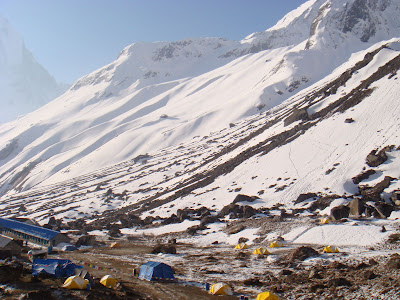 Day 5 (April 29): ABC – to- Dovan
Day 5 (April 29): ABC – to- DovanBarada and Arvind had problem sleeping at night and Barada in particular wasn't feeling good and though it was because of altitude sickness. Nonetheless we climbed another 150 mtrs on a ridge overlooking the base camp and views from there were stunning. All around us where the huge snow clad mountains. The Machhapuchre ,Annapurna south, Annapurna 1, Hinchuli and other peaks.

(Arvind and Barada on ridge with Annpurna in background)
The basecamp looked tiny and ephemeral in such surroundings. Around 11 am we started to descend from ABC to MBC, Deurali, Himalya and finally to Dovan. Even though we could have gone till Bamboo, we decided to stay for night in Dovan.
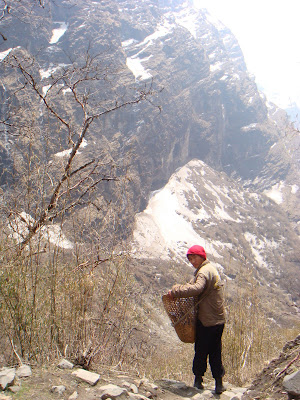
(Way back from MBC to Deurali)
Day 6 (April30) Dovan to Chomrong
We started leisurely from Dovan and descended to Bamboo. From Bamboo we trekked up to steep Khuldi ghatStaircase and rested for one hour on a beautiful fountain. Form Bamboo we trekked back to Sinuwa and then descended to Lower Chomrong and from there familiar thousand stony steps took us to Upper Chomrong and we had pizza again at Chomrong guesthouse. The local wine was nice but only after surviving first few bitter swigs. We stayed at Chomrong at same lodge where we had stayed while trekking to ABC.
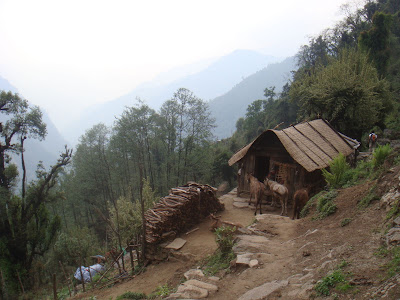
(Trekking down to Chomrong)
Day 7 (May1): Chomrong to- Jhinu – to--Birthanti- Nayapul-PokhraForm Chomrong we took a different route and instead of going to Ghandrug, we descended to Jhinu Danda. 15 mins walk away from Jhinu Danda is Jhinu hot springs. Our original plan was to have a rest day somewhere on the trail but we changed plans and decided to end the trek on same day.
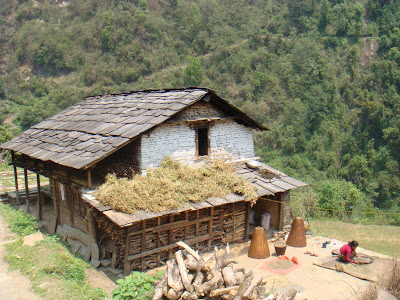
(A Neplai village house on way from Jhinu Danda to New bridge)
So we trekked from Jhinu danda to New bridge and then to Kyumi village where we had beer and lunch. After lunch and towards evening we started trek to Sayali bazar and then down to Birthanti.

(While going to Birthanti from Kyumi village)
By the time we reached Nayapul, it was dark and late in evening. We saw the buses and taxis and trek was finally over. Taxi driver were haggling for price to take us to Pokhra and buses were overcrowded. On spur of moment we decided to travel on roof of a bus and it was fantastic. With some rum mixed with coke, jokes on Barada man and some songs, the journey through the Pokhra valley in darkness on top of bus roof was the very apt end of a wonderful trek.
Day 8 (May 2): Pokhra –to-Kathmandu

(Pokhra on lake side)
Our return flight from Pokhra to Kathmandu was at 4 pm and as luck would have it flight was cancelled due to heavy rains and bad weather. Couple of Nepalis girls at airport offered to share taxi with us to Kathmandu and soon 7 of us were in a mini van (called Micros by locals ) driving in rains to Kathmandu. It was a fun ride with beer and music and we reached Thamel around 10 pm.
Day 9 (May3) Kathmandu -to-Delhi
We did some shopping in Thamel and took our respective flights to Delhi to return to world of frenetic jobs, noisy traffic and maddening rush. The mountains were left behind. I felt as if a part of me was left behind too and I know that I will return soon. If not to Annapurna then somewhere else in Himalayas. Nepal is trekker’s paradise, people in its hills are simple and friendly and there is no other way to un-clutter yourself than to trek in wilderness away from TV, phones, internet and luxuries of modern consumerist life.
Just like in most estern civilisations, Nepalis treat Annapurna and Macchapchure as Goddess or abodes of Gods. Reason is that these are not ordinary mountains. These moutains sustain human life. Every morning the skies are clear and sun shines brighter on them. The sun heats the snow on peaks and clouds form bringing fresh snow and rain. Snow and glaciers melts to form streams and then rivers which flow to plains giving us water to drink and water to produce grains. If we temper with this cycle, the repurcussions could be imagined.
